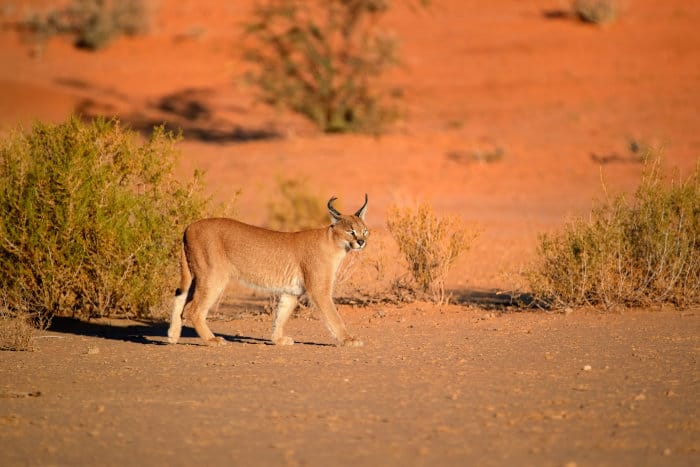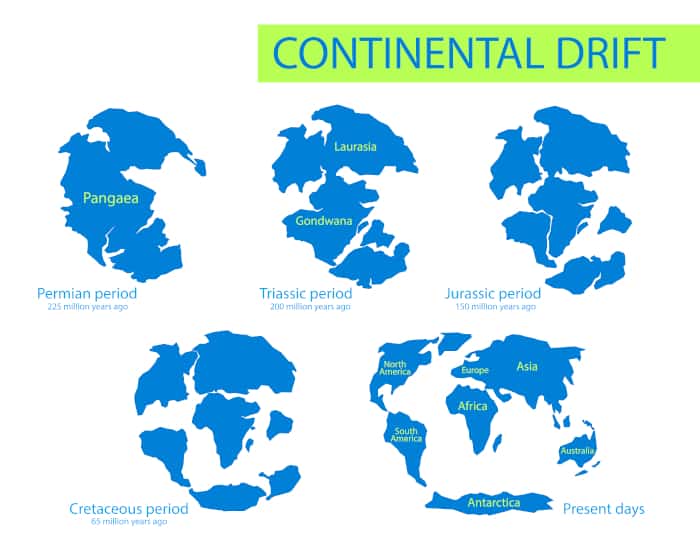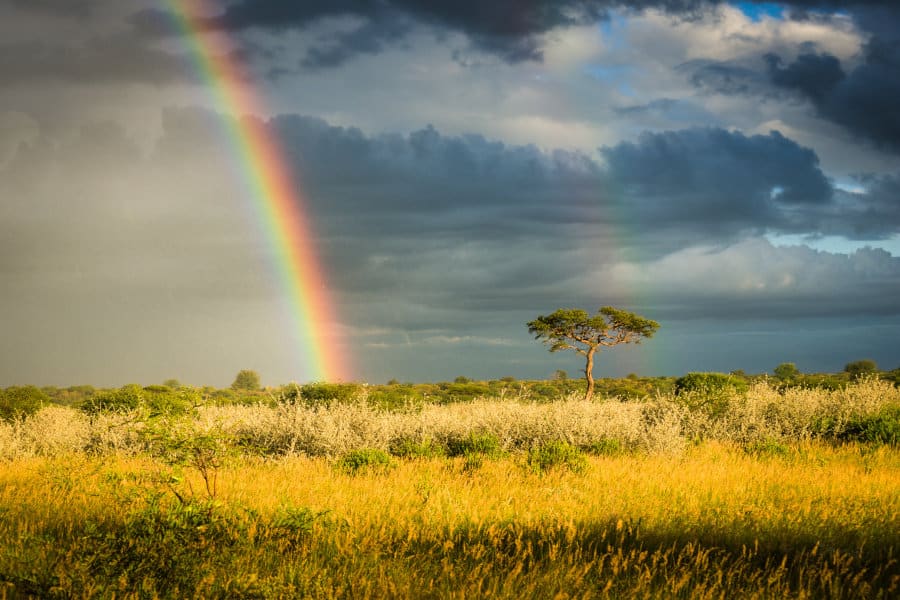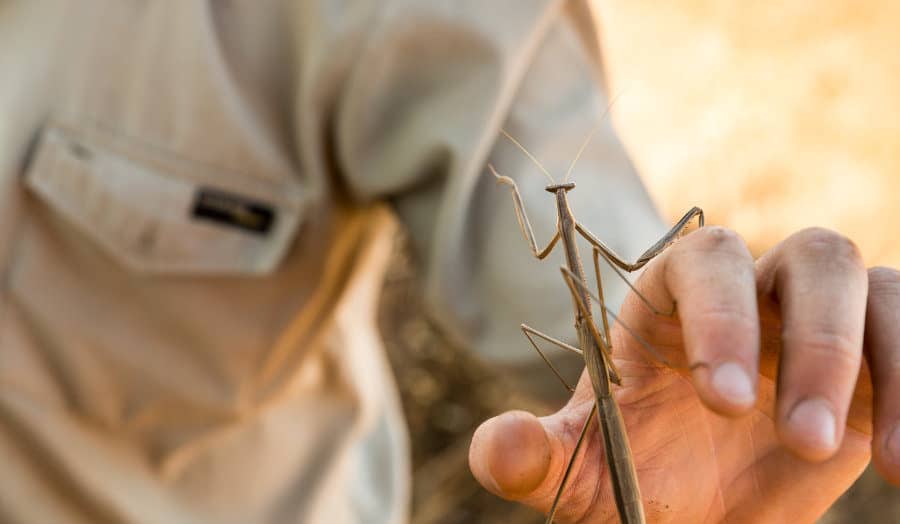The Kalahari Desert has been around since the formation of Africa sixty million years ago. It is home to some of the most prized wildlife and landscapes and is truly one of the world’s greatest natural beauties.
Compared with many deserts that are just vast, arid expanses of sand, abundant rainfall in the Kalahari has allowed for a thriving landscape.
Despite past explorers labeling it as the “waterless place”, it is home to a variety of plant and animal life, making it a unique destination.
There is much more to the Kalahari than meets the eye. It is a place steeped in history as ancient as time itself.
Here are some things you may not have known about this magnificent African plain.
13+ Facts About the Kalahari Desert
You may be wondering, “where is the Kalahari Desert?”, or whether there “are any animals in the Kalahari”. If so, read on to discover some interesting facts about this African expanse.
1. The Kalahari Desert spans multiple countries

The Kalahari Desert location spans three countries; parts of the Northern Cape in South Africa, the eastern section of Namibia, and a large part of Botswana. It is the southernmost desert in Africa.
2. The Kalahari is the second-largest desert in Africa
The Kalahari Desert is larger than you might think. In fact, it’s the second largest desert in Africa, after the Sahara. The Kalahari merges with one of Africa’s oldest deserts, the Namib Desert.
It is not only one of the largest deserts in Africa. It is one of the world’s top ten largest deserts, comprising 360 000 square miles.
3. Experts estimate that the Kalahari Desert came into existence approximately 60 million years ago

How old is the Kalahari Desert? Well, almost as old as the African continent itself.
Experts believe that the Kalahari desert formed between 60 million to 135 million years ago, during the Cretaceous period. This is not too far from the formation of the African continent itself.
4. The San Bushmen (Saan) have lived in this desert for over 20 000 years
The Khoisan people are one of the world’s most well-known indigenous hunter-gatherer groups. Thought to be the earliest inhabitants of this arid landscape, the San people stay in this area to this day.
But how could anyone survive in the desert? The San people are highly skilled hunters and gatherers. They carry incredible knowledge about the indigenous Kalahari animals and plants.
They are very familiar with the landscape and even know where to find water in the Kalahari or which plants have medicinal properties.
5. The Kalahari Desert features in a video game

Who would’ve thought this ancient desert would feature in a video game? The Kalahari Desert serves as the final race course in the classic Nintendo video game Mario Kart 64.
In the game, its name is the “Kalimari Desert” — a combination of the words “calamari” and “Kalahari”.
6. The Kalahari desert appeared in various films
If you think the Kalahari Desert looks familiar, you might have The Lion King to thank. Yes, this critically acclaimed 1994 film features scenes and characters inspired by the Kalahari landscape and wildlife.
This desert is home to the black-maned Kalahari desert lions and meerkats. Plenty of giggling hyenas also live here.
Other films boasting the Kalahari as a film set include Sands of the Kalahari, The Kalahari Horse, and Riding Tornado.
One of the most popular films set in the Kalahari, however, is the popular (and adorable) BBC docu-series Meerkat Manor. The series follows a family of meerkats – the Whiskers – living in the Kalahari.
7. One of the world’s largest diamond mines is in the Kalahari Desert

People discovered diamonds over 50 years ago in the Kalahari Desert. This led to the creation of some of the world’s biggest diamond mines in and around the area.
This includes the Orapa diamond mine, the world’s largest open-pit mine, and the Jwaneng diamond mine in south-central Botswana.
The latter is said to be the richest diamond mine in the world. The Kalahari Desert is also rich in reserves of nickel, copper, and coal.
Sadly, these highly profitable mines come at a cost to the native San people, who, in many cases, have been evicted from their homeland.
The mining industry additionally has a detrimental effect on the desert ecosystem, as companies ruin large sections of vegetation to create mines.
8. The Kalahari is home to many of the world’s largest cats — and other animals
While the arid conditions may seem less than ideal for survival, Kalahari Desert animals have adapted to the environment. This desert is home to all three of Africa’s big cats; the spotted cheetahs, elusive leopards, and majestic lions.
Other animals that live in the Kalahari include springbok, meerkat, hyenas, and birds of prey like martial eagles and the eagle owl. You’ll also find reptiles like Cape cobras and even some frogs, like the bushveld rain frog.
9. The Taa language originated in the Kalahari area
Some people native to the Kalahari region in Botswana and Namibia speak a very rare and unique language known as Taa.
This language has more vowels and consonants than any other known language. Linguists estimate that the language contains the largest sound inventory of any world language.
The Taa language involves over 80 click sounds, different tones, and 20 vowels. Taa is considered an endangered language due to there being less than 5000 speakers of the language.
10. There were once plans for large-scale irrigation in the Kalahari
While people refer to the Kalahari as a desert, it’s not all sand and rock. The Kalahari actually receives a significant amount of rain each year, especially in the central, northern, and eastern parts.
The rain helps certain plant life like Hoodia (cactus-like succulent), shrubs, and various species of Acacia grow in the desert.
There were once hopes to make the desert even more fruitful, with plans to implement large-scale irrigation systems that would make the desert viable for agriculture. These plans have, however, yet to become a reality.
11. It was formerly believed that the ruins of a lost city had been discovered in the Kalahari

In 1886, explorer Guillermo Farini published a book about some rock formations he found in the Kalahari. This book led to a quest to find the Lost City of the Kalahari.
This “lost city” was never found, leading to suspicions that he merely mistook some natural rock formations for something man-made.
12. A river flows through the Kalahari
One of the more surprising facts about the Kalahari Desert is that a river runs through it. The Okavango River stretches for 994 miles, starting in central Angola and ending in the northern part of the Kalahari.
Every year, the Okavango River slowly floods the Okavango Delta, a verdant oasis in the desert comprising over 8000 square miles of lagoons and waterways.
The delta usually has the most water between April and May, gradually drying up before filling with water again the following year.
Various wildlife lives around the Okavango Delta, including zebras, black rhinoceros, African buffalo, and blue wildebeest.
13. Kalahari translates to “large thirst” or “dry place”

What is the Kalahari Desert named for? The desert’s name comes from the Tswana word “kgala”, which roughly translates to “large thirst” — not surprising considering it is a desert.
It also derives its name from a similar Tswana word, “kgalagadi”, approximately translating to “place of thirst”.
14. The Kalahari technically isn’t a desert
As you may have thought to yourself by now, the Kalahari doesn’t exactly qualify as a desert. This is due to its high rainfall.
The drier parts of the Kalahari receive between 5-10 inches of rain yearly, putting it well above the average rainfall for a desert. During very wet years, the more northern parts of the Kalahari can receive up to 20 inches of rain.
While it might not qualify as a desert in the strictest sense, the Kalahari’s sand doesn’t have much surface water, as rain drains through almost immediately. So it’s still a relatively arid place.
Would You Visit the Kalahari Desert?

Now that you know where the Kalahari is and what makes it so special, would you want to visit this stunning destination?
With its incredible history, vast wildlife, and unique beauty, the Kalahari makes for one of the best safari destinations in Botswana, Africa.
Looking for more stunning stretches of land to add to your African safari bucket list? Why not consider visiting the Kruger National Park or Addo Elephant Park in South Africa?



